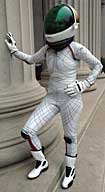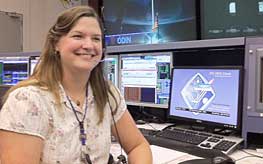
January 2011In this issue: |
|||
|
|||
Amy Brzezinski is a fledgling flight controller for the International Space Station. |
4. Winging it with the Navy
When we heard from alum LT David Tarr SM '08 in October he was undergoing his training as a Naval aviator. David now writes, "I am happy to report (on) my successful completion of flight school! After my carrier qualification, which was the most thrilling fun I've had yet, I spent a month out in the desert of California learning different types of weapons delivery and low-level formation reconnaissance/attack. Back in South Texas, the final push through Air Combat Maneuvering got me up the magic date of November 19 when I earned my wings of gold and my designation as Naval Aviator. I was fortunate enough to earn my first choice of assignments — flying F/A-18E/F Super Hornets out of NAS Oceana, VA. I am now out in Virginia Beach beginning my training in the Super Hornet with the VFA-106 Gladiators." Good show, David!
A happy David Tarr has just learned he's been selected as a Naval Strike pilot. |
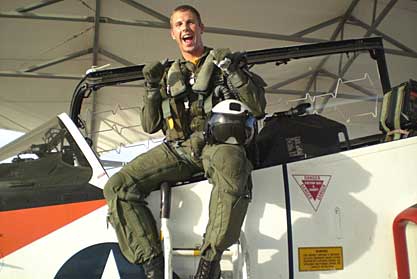 |
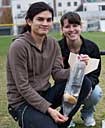
Julian Lemus and Giulia Pantalone with their bagel booster.
5. Water, not LOX, fuels Unified's bagel rockets
Professor Dave Darmofal reports that the fall term Unified Water Rocket Competition was held on November 15 and all teams achieved the design requirements. The student teams had to design a water rocket to launch a bagel (yes, a bagel) to 40 meters while minimizing the amount of water used for propulsion. The score in the competition was based on not only the water mass used by the team's rocket but also the team's accuracy in predicting the water mass. Peter Ortez and Jed Storey won the competition using only 230 grams of water (having predicted 210 grams would be needed). Dave noted that a key in the victory was Peter and Jed building and flight testing their rocket prior to the competition allowing them to improve the accuracy of their analysis. Congratulations to everyone!
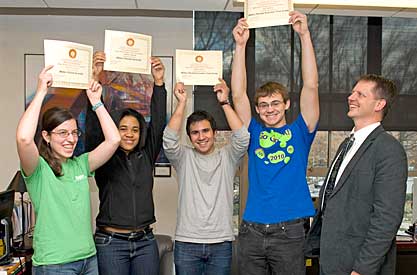
Professor Darmofal looks on as 2010 Unified Water Bottle contest winners (from left) Elizabeth D'Arienzo, Chelsie Librun, Peter Ortez, and Jed Storey hoist their official "(Water) Rocket Scientist, First Grade" certificates.

Erika Wagner is heading for Seattle.
![]()
6.Comings and goings
Welcome to our new postdocs: Alejandra Uranga, with Professor Greitzer; Ankur Srivastava and Jinglai Li, with Professor Marzouk; Rebecca Masterson and Jaime Luis Ramirez Riberos, with Professor Miller; and Nabiko Yamamoto, with Professor Wardle.
Joe Aylward has joined AeroAstro as a financial assistant. He's assisting Jennie Leith and Ping Lee.
Robert Malina has arrived in the department as a visiting scientist working with Professor Waitz.
Sophia Hasenfus is our new administrative assistant, supporting Professors Leveson, Marzouk, Roy, and Williams.
Former AeroAstro lecturer, Erika Wagner SM '02 PhD '07, is heading west for new adventures. Building on her experience as X PRIZE Lab@MIT founding executive director, she will be helping in Seattle with the newer cousin X PRIZE Lab@UW, as well as working directly with X PRIZE on its next generation of innovation competitions. Erika says that with her husband working on the new Boeing 787 Dreamliner, the whole family is ready to explore "Jet City."
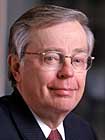
Kent Kresa
7. Kresa talk video posted
If you missed the December 1 lecture by AeroAstro alum Kent Kresa '59, '61 M.S., '66 E.A.A., former chief executive and chairman of the board of the Northrop Grumman Corporation, you can catch it now on MIT World. Kresa's talk "An Engineering Career -- 50 Years Out," starts with his student days when he worked in Boeing's wind tunnel, covers his time with Lincoln Lab, Avco, DARPA, his time as Northrop chief, and culminates in his appointment by President Obama as GM interim director. The talk was the 2011 AeroAstro Lester D. Gardner Lecture and the School of Engineering Distinguished Lecture series.
![]()
8. MIT acronyms: add yours
Two of MIT's most prolific products are acronyms and initialisms. How many times have you nodded sagely as colleagues drop a string of letter combinations when, in fact, you have no idea what they're referring to?
If you're confronted with a mystery abbreviation, there's help available — the MIT Acronyms website. From "A" ("After subject number- subject approved for graduate degree") to "Zeta Psi," there are hundreds of acronyms explained.
There's been a major change to the acronym site since we first reported on it in 2006; it's now a wiki so anyone with an MIT certificate or Kerberos identity can make additions and changes. Take a moment, visit the site, and make sure your DCL is represented. And, maybe soon there'll be an app so you can halt your colleague in mid-conversation, pull out your smartphone, and grab that MIT acronym on the spot.
Follow AeroAstro
Don't wait for your enews and emails — keep up with AeroAstro news as it happens — follow the department on Twitter and Facebook.
